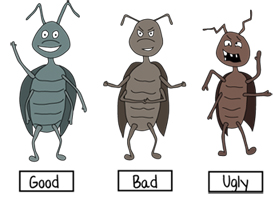|
Part of making an insect collection is learning how to correctly classify the specimens. This is a very challenging assignment, because there are so many insects and so many of them look alike. Do not be discouraged if there are specimens that cannot be identified. Remember that even professional insect taxonomists (entomologists who identify and classify insects) cannot identify every species of insect. Some must specialize in working with one group and others with another group.
Classification, the grouping and naming of insects, is an ever-changing science. Insect specialists separate and combine groups of insects based largely upon their morphological similarities, some having more influence in a decision than others. As such, this process is somewhat subjective and, thus, dynamic. A student of entomology may find slight differences in classification schemes depending upon which reference or which
entomologist they consult, and these may change over time.
Not all orders of insects are the same size. For example, more than one-third of the named species of insects (300,000) are in one single order, the Coleoptera (beetles). The next largest orders are Lepidoptera (butterflies and moths), with 150,000 species; and Hymenoptera (wasps and bees), with 125,000 species. The order Diptera (flies) includes about 20,000 species. These four orders, Coleoptera, Lepidoptera,
Hymenoptera, and Diptera, comprise more than 80 percent of the named species of insects.
Approximately 92,000 named species of insects occur in the United States and Canada. It is not known how many of these species occur in any one state or in even a small area within a state. A list of insects in New York, published in 1928, included more than 15,000 species, but hundreds of species have been discovered there since that time. States such as California, Arizona, Texas, and Florida probably far exceed the Midwest and Northern states in the total number of species of insects.
Estimates of the number of species for three representative states and also for all of USA and Canada are provided as an indication of the number of species that insect collectors may expect to find (Table 1). A collector who can find one or more representatives of each of the 24 orders discussed in this book will have a very diverse collection, and in so doing will learn a great deal about insects and their habits.
| Table 1. Estimated Number of Species |
| Order |
North Carolina |
New York |
Indiana |
USA & Canada |
World Wide |
| Collembola |
169 |
200 |
200 |
314 |
9000 |
| Thysanura |
6 |
5 |
7 |
25 |
900 |
| Ephemeroptera |
121 |
61 |
120 |
690 |
3100 |
| Odonata |
148 |
159 |
150 |
425 |
5500 |
| Dictyoptera |
23 |
15 |
20 |
101 |
5800 |
| Orthoptera |
235 |
121 |
150 |
925 |
20000 |
| Dermaptera |
7 |
4 |
5 |
18 |
2000 |
| Isoptera |
5 |
1 |
5 |
41 |
2900 |
| Plecoptera |
94 |
59 |
85 |
408 |
2000 |
| Psocoptera |
37 |
38 |
30 |
150 |
4400 |
| Mallophaga |
164 |
53 |
90 |
318 |
4000 |
| Anoplura |
11 |
11 |
15 |
62 |
900 |
| Thysanoptera |
64 |
71 |
150 |
600 |
5000 |
| Hemiptera |
568 |
727 |
800 |
4600 |
40000 |
| Homoptera |
759 |
864 |
900 |
6700 |
50000 |
| Neuroptera |
68 |
61 |
65 |
338 |
6500 |
| Megaloptera |
9 |
10 |
15 |
61 |
300 |
| Coleoptera |
3336 |
4546 |
4424 |
30000 |
350000 |
| Mecoptera |
27 |
20 |
20 |
89 |
600 |
| Trichoptera |
161 |
174 |
210 |
980 |
11000 |
| Lepidoptera |
1428 |
2439 |
2000 |
10100 |
150000 |
| Diptera |
2595 |
3615 |
3600 |
17000 |
120000 |
| Siphonaptera |
14 |
26 |
28 |
250 |
2500 |
| Hymenoptera |
2463 |
2300 |
2800 |
17000 |
125000 |
|

